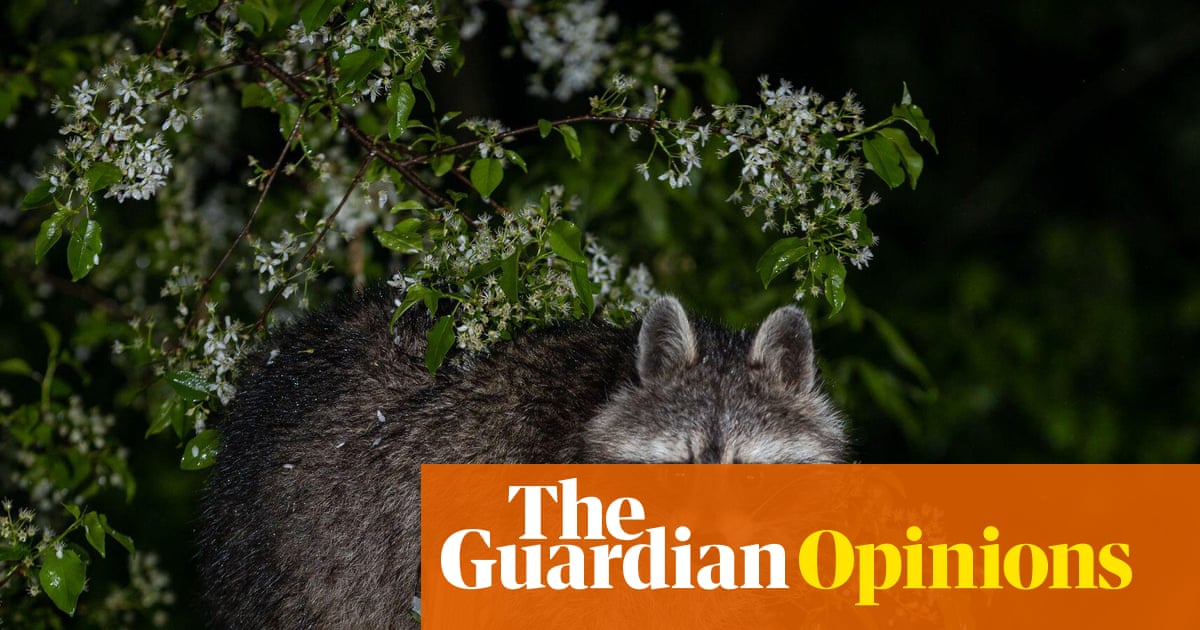I have kept many pets over the years. Some, like my current canine companion, have been both adoring and adorable, but others have been less successful. I’m thinking of the hamster who scarfed down her babies, the cockerel who karate-kicked the kids and our current cat, who is so aloof that she says “meh” instead of “miaow”.
So it was with interest that I learned that urban raccoons in North America are showing signs of domestication. A study in Frontiers in Zoology suggests that the animals are evolving to be – as the mainstream media puts it – “cuter” and “more pet-like”. Jump ahead three thought bubbles and I’m picturing me, holding paws with my new pet, skipping through the daisies to the tune of Daydream Believer. But could this really be?
According to prevailing wisdom, humans have been domesticating wild things for at least 30,000 years. Dogs were first, followed by chickens, sheep, pigs and more. As food became easier to source, people put down roots. The hunter-gatherer way of life gave way to settlements, cities and complex societies. Clever old us, working it all out.
Only it didn’t quite happen that way. In its earliest stages, domestication isn’t about humans choosing to do anything. It’s more about animals choosing us, or more precisely, the places where we live.
When raccoons first tiptoed into our towns, they noticed two things: a lack of large predators and an abundance of bins. The wary backed away but the least skittish took advantage. With their stomachs full of burgers, these were the animals most likely to survive and pass on their “not so skittish” genes to the next generation. Over time, the city-dwelling raccoons became bolder. This is natural selection at its finest. So humans didn’t decide to start domesticating the raccoon – the so-called trash pandas started domesticating themselves.
To those who live near raccoons, this should come as no surprise. These are super-smart animals with a can-do attitude. They ride the subway, camouflage themselves as lampshade pendants and organise Mission Impossible-style heists. In one incident a raccoon descended from the ceiling of a Toronto bakery to steal an orange doughnut.
To the brazen belong the spoils, but that’s not all. The study, from researchers at the University of Arkansas, found that the snouts of urban-dwelling raccoons are 3.5% shorter than those of their rural counterparts. This, they say, is the key sign that domestication is taking place.
Scour the range of domesticated animals, from goats to guinea pigs, and you’ll notice a collection of common features that crop up again and again. These include decreased brain and body size, shorter snouts, floppy ears, curly tails and patchy markings. Collectively these features are referred to as domestication syndrome, and the idea is that as animals become tamer over time, these other features often hitch along for the ride.
Evidence for this comes from the work of the late Russian geneticist Dmitry Belyaev, who started breeding silver foxes (a colour variant of the red fox) in 1959. Each generation he chose the calmest, least fearful animals and let them produce offspring together. Ten generations later, the animals were becoming friendlier and starting to acquire piebald markings, droopy ears and curly tails. This was followed by changes to their skeleton, including shorter snouts and legs. Belyaev didn’t set out to make flatter-faced, waggy-tailed foxes, but that’s exactly what he got.
There is a theory that says this quirk occurs because the process of domestication, and the many small genetic changes that underpin it, affect the behaviour of a group of cells called the neural crest. During embryonic development, neural crest cells disperse through the body, where they help to make certain cells (including pigment cells), organs (such as the adrenal gland, which controls the stress response) and structures (such as the ears, snout and tail). Once animals begin being selected for “tameness”, or more docile behaviour, controlled by the adrenal glands, all the other features affected by neural crest cells start changing too.
skip past newsletter promotion
Sign up to Matters of Opinion
Guardian columnists and writers on what they’ve been debating, thinking about, reading, and more
Privacy Notice: Newsletters may contain information about charities, online ads, and content funded by outside parties. If you do not have an account, we will create a guest account for you on theguardian.com to send you this newsletter. You can complete full registration at any time. For more information about how we use your data see our Privacy Policy. We use Google reCaptcha to protect our website and the Google Privacy Policy and Terms of Service apply.
after newsletter promotion
The findings of the raccoon study align with this theory and suggest, tentatively, that if this domestication continues, raccoons too could acquire floppy ears and waggy tails. So if you think raccoons are cute now, just wait till this happens!
But don’t expect to preorder your pet raccoon just yet. The raccoons of North America remain in the very earliest stages of domestication. We know from the evolutionary history of dogs that if full domestication is ever to happen, humans will need to step in and deliberately start selectively breeding them. This “artificial selection” is what has created the many thousands of domestic breeds we have today.
In the meantime, close your windows and lock up your leftovers, because for as long as we continue to leave food around, the trash pandas will continue to find it. And to the people of North America, I say this: you can choose to love or hate them, but please love them. Raccoons are living embodiment of the Wombles, making good use of the things that they find, things that the everyday folks leave behind.

